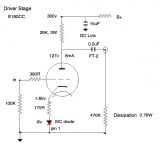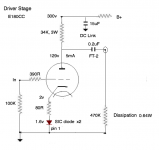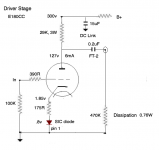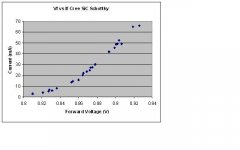What is you input sensitivity you require? The standard 0.2-0.3 Vrms or less sensitivity? Because in the latter case you can do it very simple:
D3a with nominal 15K plate resistor and 170R cathode resistor (or LED bias for 1.7V). But that's what I call a power amp. Having 310V to start with you can form the plate resistor with 3x47K in parallel. For 10 mA you are going to drop about 156-157V + 150V anode voltage + bias. The 2A3 grid resistor should be ok in the 150k-220K range.
This way you should get full power with 0.6-0.7Vrms input.
If then you want to make it a real integrated amp I suggest the 1:2 Sowter 1475 with a 22K volume pot across the secondary. This is in regular production and does not require any networks or other acrobatics to get to 90KHz smoothly. The way it is made also gives very good common mode rejection and allows both unbalanced and balanced drive. It's a true 10K input transformer with 130H primary inductance....
D3a with nominal 15K plate resistor and 170R cathode resistor (or LED bias for 1.7V). But that's what I call a power amp. Having 310V to start with you can form the plate resistor with 3x47K in parallel. For 10 mA you are going to drop about 156-157V + 150V anode voltage + bias. The 2A3 grid resistor should be ok in the 150k-220K range.
This way you should get full power with 0.6-0.7Vrms input.
If then you want to make it a real integrated amp I suggest the 1:2 Sowter 1475 with a 22K volume pot across the secondary. This is in regular production and does not require any networks or other acrobatics to get to 90KHz smoothly. The way it is made also gives very good common mode rejection and allows both unbalanced and balanced drive. It's a true 10K input transformer with 130H primary inductance....
Last edited:
Isn't it time to subject one of these amplifiers you have tried to some objective testing to discover
what 'tonality' equates to in terms of there spectral response? And how does that relate to the loudspeaker
and/or the headphones used in your subjective tests?
And please don't tell me the test equipment doesn't tell the truth. Otherwise how are
we to access your results at a distance while using other loudspeakers, etc in a different environment.
what 'tonality' equates to in terms of there spectral response? And how does that relate to the loudspeaker
and/or the headphones used in your subjective tests?
And please don't tell me the test equipment doesn't tell the truth. Otherwise how are
we to access your results at a distance while using other loudspeakers, etc in a different environment.
Attachments
Good question of how to access "tonality" in a different test environment - I appreciate the question and I totally agree with testing equipment. But I don't have anything like the sophisticated equipment needed to look at spectral responses, so can't help there. And how test results relate to tonality is a very advanced theoretical discussion which goes well beyond THD. I leave that to those who are experts in this field. I can only provide subjective A-B listening results with the same input and speakers. I'm a conservatoire trained pro musician who has played in orchestras, jazz and rock bands, theatres etc and I have the sounds of acoustic instruments indelibly imprinted on my brain after a lifetime of playing right next to them. So that's what I'm basing "tonality" on, and that's what I have to satisfy in all equipment choices in the audio chain. I'm very demanding in terms of the timbre of acoustic instruments, and orchestral instruments are very revealing of this. But at the end of the day we all have to decide on circuit designs which help us achieve our goals, whatever these are. Solutions have to "perform" of course, but they also have to satisfy in listening tests. I'm sure I'm just stating the obvious here.Isn't it time to subject one of these amplifiers you have tried to some objective testing to discover what 'tonality' equates to in terms of there spectral response? And please don't tell me the test equipment doesn't tell the truth. Otherwise how are we to access your results at a distance while using other loudspeakers, etc in a different environment.
Last edited:
The sound of an instrument when you are in the band . . .
. . . is different than the sound of the same instrument when you are in the audience.
The attenuation rate versus distance of low frequencies is different than the attenuation versus distance of high frequencies.
And, the sound of speakers is different depending on near field, far field, and the room size and reflectivity.
Perfect sound is not reproduced. It is only available live, and being there.
True, it is good to improve our playback systems, and get closer to the sound we want.
But many of us can be very pleased with our less than perfect playback systems.
We had a French horn player who could make the most perfect looking sine wave, and could also make the characteristic wave that had the fundamental and the French Horn characteristic 2nd harmonic "curve ripple on the way down in the 2nd quadrant. He could also get enough lip in the mouthpiece to play pedal tones that most professional French Horn players could not play.
I sat in bands. I sang in the choir. Those were thrilling moments.
So are many times with less than perfect playback systems (mine and other peoples).
Just my opinions.
. . . is different than the sound of the same instrument when you are in the audience.
The attenuation rate versus distance of low frequencies is different than the attenuation versus distance of high frequencies.
And, the sound of speakers is different depending on near field, far field, and the room size and reflectivity.
Perfect sound is not reproduced. It is only available live, and being there.
True, it is good to improve our playback systems, and get closer to the sound we want.
But many of us can be very pleased with our less than perfect playback systems.
We had a French horn player who could make the most perfect looking sine wave, and could also make the characteristic wave that had the fundamental and the French Horn characteristic 2nd harmonic "curve ripple on the way down in the 2nd quadrant. He could also get enough lip in the mouthpiece to play pedal tones that most professional French Horn players could not play.
I sat in bands. I sang in the choir. Those were thrilling moments.
So are many times with less than perfect playback systems (mine and other peoples).
Just my opinions.
Last edited:
In terms of "simple solutions" it doesn't get much simpler than a resistor as anode load and an unbypassed cathode resistor. For a B+ of around 300v this requires an extra diode in the cathode, in this case a Cree SIC diode giving 0.8v. This leaves an unbypassed cathode resistor of 180 ohms for around 6mA of current. We then need a valve with a mu of 40 or more and a Ra of round 7K. This points to the E180CC which is a pretty good sounding valve. And indeed this setup gives good sound. Not the ultimate in tonality but certainly in the ballpark. I like resistor loads - they sound clean and smooth. Get them to work and they usually satisfy. I'm not a great fan of diodes in the cathode, but in combination with a series resistor they become a useful tool.


The sound of an instrument when you are in the band . . .
. . . is different than the sound of the same instrument when you are in the audience.
Just my opinions.
And the sound of three trumpets playing a chord. If the three trumpets are being "mixed" in the air vs. if the three are being "mixed" using electrons in a circuit... is different too. The latter has all the artificial IM distortion of the circuit. Mixing the three notes of that chord "in the air" will not have any of that distortion. Air is the best "mixer".
To decrease the size of the unbypassed resistor. You can use one or two diodes, and here's a version with 2 diodes. I haven't tested this directly against one diode (which I'm listening to) but I'll probably get round to it.Why did you include a silicon diode in the bias circuit?
I'm cautious with these SIC diodes - they do give a bit more attack to the leading edge of notes. A little helps definition, but you don't want more than a little. There are a few makes of these diodes. Mine are Cree C3D02060F but I think they're no longer available. Genesic do GC02MPS12-220 which is 1200v. Useful in power supplies.

Pls post the data set that created that plot. I'd like to compare it to a 1N4007.The diode act as ideally bypassed (in this case 133R= 0.8V/6mA) resistor, but at -relatively- constant voltage (about 0.8V) and has very low impedance (2.5 ... 3R).
BTW voltage is not constant, but it changes relatively little with current (at low current area).
View attachment 1043258
THX
Ask Magz, who posted it:
https://www.diyaudio.com/community/threads/class-a2-direct-mosfet-coupled-se.144767/page-7
https://www.diyaudio.com/community/threads/class-a2-direct-mosfet-coupled-se.144767/page-7
On my Aa driver tube (3mA) the bias was a single 2V LED. The sound was sterile, flat and uninspiring. Then, I switch to filament bias using a Mundorf 10W resistor and immediately the tonal color was glorious. More natural. String vibrations and related 2nd harmonics could be heard. So, I am moving away from LED bias. Just as a rough rule of thumb: as Fixed bias for voltages >5Vdc and filament bias <5Vdc.
If you are up close to three trumpets playing a chord, and the acoustic sound level is large, human ears have significant levels of both harmonic distortion, and intermodulation distortion.
If you are further away from those three trumpets playing a chord, and the acoustic sound level is much lower, human ears have in-significant levels of both harmonic distortion, and intermodulation distortion.
Just my opinions.
If you are further away from those three trumpets playing a chord, and the acoustic sound level is much lower, human ears have in-significant levels of both harmonic distortion, and intermodulation distortion.
Just my opinions.
I have never liked E180CC and other computer tubes as voltage amplifiers. They generate significant 2nd harmonic distortion even at low levels.We then need a valve with a mu of 40 or more and a Ra of round 7K. This points to the E180CC which is a pretty good sounding valve. And indeed this setup gives good sound. Not the ultimate in tonality but certainly in the ballpark. I like resistor loads - they sound clean and smooth. Get them to work and they usually satisfy. I'm not a great fan of diodes in the cathode, but in combination with a series resistor they become a useful tool.
View attachment 1043204
But you might be getting some 2nd H cancellation as the 2A3 is not a champion in this department too.
That's a power amp by the way, you will need no less than 1 Vrms to drive it to full power. Might be good as "integrated amp" with some digital sources as is but not in general.
Yes - it's a power amp. I don't make integrated amps. I run my amps directly off a DAC with the usual 2v line out signalThat's a power amp by the way, you will need no less than 1 Vrms to drive it to full power. Might be good as "integrated amp" with some digital sources as is but not in general.
The E180 is an "acceptable" valve. I've never got on with 6922 or 12AT7 but I can do something with the E180CC and maybe its variants like 12AV7 and 6414.
I use the same combo in my 26 with 3 Sic + 2R7 or 2R2 and the sound is very goodIn terms of "simple solutions" it doesn't get much simpler than a resistor as anode load and an unbypassed cathode resistor. For a B+ of around 300v this requires an extra diode in the cathode, in this case a Cree SIC diode giving 0.8v. This leaves an unbypassed cathode resistor of 180 ohms for around 6mA of current. We then need a valve with a mu of 40 or more and a Ra of round 7K. This points to the E180CC which is a pretty good sounding valve. And indeed this setup gives good sound. Not the ultimate in tonality but certainly in the ballpark. I like resistor loads - they sound clean and smooth. Get them to work and they usually satisfy. I'm not a great fan of diodes in the cathode, but in combination with a series resistor they become a useful tool.
View attachment 1043204
Sorry if this is a dumb question.. but what's the motivation for these options? Looks like the goal is to get the highest possible gain out of one stage to avoid having a second one?
While one stage might be cleaner than two (all other things being equal), a design with just resistance on the plate and cathode would be more linear - probably enough so that two such stages would outperform a single stage with a horizontal AC load line.
Rather than using diodes on the cathode (which could have significant temperature effects), why not just use two series resistors and decouple the one you don't want in the AC characteristic?
While one stage might be cleaner than two (all other things being equal), a design with just resistance on the plate and cathode would be more linear - probably enough so that two such stages would outperform a single stage with a horizontal AC load line.
Rather than using diodes on the cathode (which could have significant temperature effects), why not just use two series resistors and decouple the one you don't want in the AC characteristic?
Why bother with chokes in a filament supply when a few dollars in silicon will give you a regulator thats more quiet than a battery? Look at the LT3045. Plenty of people selling ready made modules using it too.
Sorry if this is a dumb question.. but what's the motivation for these options? Looks like the goal is to get the highest possible gain out of one stage to avoid having a second one?
While one stage might be cleaner than two (all other things being equal), a design with just resistance on the plate and cathode would be more linear - probably enough so that two such stages would outperform a single stage with a horizontal AC load line. Rather than using diodes on the cathode (which could have significant temperature effects), why not just use two series resistors and decouple the one you don't want in the AC characteristic?
That's an idea - I've done that before but can't remember the results, it was years ago.
I have a modular system of top plates which allows me to kind of breadboard circuits pretty quickly, so I just run through a variety of options and listen to them for anything that sounds good. It needs a valve that sounds pretty good for starters, and then some way of optimising the operating point and the circuit topology. Active loads have never made it into my ballpark of sounds I want to listen to, still waiting for that to happen. Plate chokes can be good - they stay on the list.
A resistor load can be good, so that stays on the list. Ideally I want an unbypassed cathode resistor but it gets too big unless you add a diode or two into the mix. Alternative is to add a bypass cap, but if you can get away with a diode it's useful. I combine a diode with a series resistor because that sounds smoother to my ears. I'm liking what I have at the moment and it makes it into the ballpark of circuits I'm happy to listen to in my system. The E180CC has the right kind of gain and it works quite nicely. For a sensitive system the E80CC is another valve I like with a diode+resistor, same idea. And some of the old European radio valves like the MH4 which was mentioned earlier on. Mu of either is around 30 though, and Rp around 11-12K so using a resistor load it would need a preamp in an average system. Not a commercial choice at all.

- Home
- Amplifiers
- Tubes / Valves
- Tube input stage - plate choke or active load?

